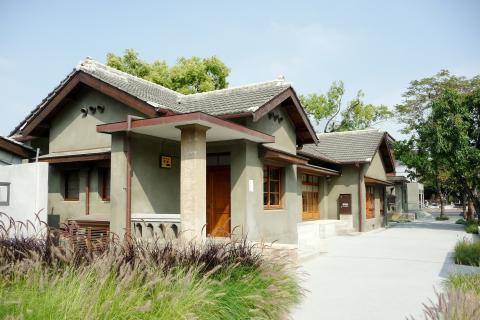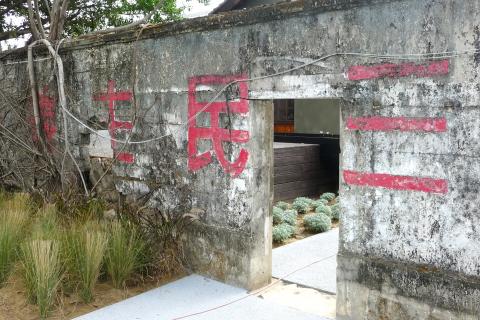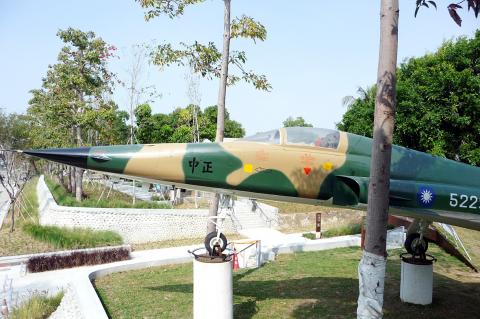Tainan, the nation’s political capital and its largest settlement between the mid-17th and late-19th centuries, is the most Taiwanese of cities. Yet even here, the political and human tsunami which hit Taiwan after World War II left marks which are still visible.
Between late 1945 and the final few days of 1949, when Chiang Kai-shek (蔣介石) lost the Chinese Civil War that his Chinese Nationalist Party (KMT) had been waging against Mao Zedong’s (毛澤東) communists, an estimated 2.2 million Chinese soldiers, officials and civilians were reassigned — or moved voluntarily, or fled in great haste — to the island. At this time, the local-born population of Taiwan was less than seven million.
Those holding or hoping for government jobs gravitated toward Taipei, while members of the armed forces and their families were housed in military dependents’ villages (juancun, 眷村) near bases all over Taiwan. Some of these villages had been built during the 1895-1945 period of Japanese rule; others were constructed hastily to accommodate the influx.

Photo: Steven Crook
A significant minority of Taiwanese now in their fifties, sixties or seventies grew up in the military dependents’ villages. They were raised by mothers who spoke Mandarin or Chinese dialects, rather than Taiwan’s local languages, and often cooked the specialties of their native provinces.
Chen Yu-jen (陳玉箴), an associate professor in the Department of Taiwan Culture, Languages and Literature at National Taiwan Normal University, has written that the typical military dependents’ village was “a relatively closed space where various Chinese dishes were preserved… For the villagers and their descendants, such relatively independent living conditions provided a safe environment where they could maintain their languages, customs, and collective memories of mainland China, as well as their food. Those who lived in these villages preserved many food habits and customs from their hometowns, including eating habits and festival dishes.”
However, it wasn’t always possible or practical to replicate recipes the Mainlanders brought with them. To some extent, what’s now known as “military dependent’s village cuisine” (juancuncai, 眷村菜) is actually an attempt to achieve Chinese flavors using Taiwanese ingredients.

Photo: Steven Crook
Some of those who’d fought on the KMT side in the 1940s ended up near an airfield 6km south of Tainan’s city center. Built in the mid-1930s by the Japanese for civilian purposes, it became a major air force base. Between 1957 and 1979, US Air Force units were stationed here. What local people call Tainan Airport (臺南機場) continues to have a dual military-civilian function, with regular flights to Taiwan’s outlying islands and to a few destinations in East Asia.
What was known as Second Air Force New Village (二空新村), a short distance east of the airport in Rende District (仁德區), was flattened some years ago. Dalin New Village (大林新村) in South District (南區) disappeared even earlier — but that neighborhood remains one of the best places in Tainan to seek out “Chinese” foods and hear Mandarin spoken with “old Mainlander” accents.
Dalin New Village occupied a good part of what’s now Sinsheng Borough (新生里), a subdivision that stretches less than 1km from Tainan Martyrs Shrine (臺南市忠烈祠) in the northeast to Tainan City Sports Park (臺南市立體育公園) in the southwest. The grounds of the shrine are never busy, and the doors of the main building have been locked each time I’ve been here. If you’d like to take a look, it’s on the corner of Datong Road Section 2 (大同路二段) and Jiankang Road Section 1 (健康路一段).

Photo: Steven Crook
Between the shrine and the park, there’s a high-rise housing project that was built on the site of the military dependents’ village in the second half of the 1990s. Judging by the number of Republic of China flags which fly throughout the year, and the accents I’ve heard here, many apartments were given to former servicemen and their families.
Several of the first-floor units house eateries, and one Mainlander-run establishment has become a personal favorite. Among the signature dishes at Jinmenguan (金門館, 3, Lane 164, Datong Road Section 2; open 11am to 2pm and 5pm to 7.30pm Monday to Saturday) is Stir-fried Sliced Pancake (牛肉炒餅, NT$100). The pancake is chopped into strips less than a centimeter wide, then stir-fried with medallions of pre-braised beef. A single portion will satisfy the hungriest traveler, but it’s best to come with a few friends and share several different items.
Mother Feng’s Shop (馮媽媽的店; 1, Alley 5, Lane 186, Datong Road Section 2; open 10am to 9pm Tuesday to Sunday) is known for its handmade Hunanese sausages and meatballs. I’ve tried the latter; they’re excellent. Their sauces and pastes also get rave reviews.

Photo: Steven Crook
Less than a kilometer west of Dalin New Village, fragments of military dependents’ villages have been preserved as the New Police Painted Village (警察新村彩繪村) and Shueijiaoshe Cultural Park (水交社文化園區).
A handful of people still live in the former, which is accessed by Lane 193, Dacheng Road Section 1 (大成路一段). This cluster of homes has become Instagram-famous thanks to colorful police, air force and cat-themed murals and mosaics — but it’s anyone’s guess if it’ll still be standing in a few years.
Shueijiaoshe Cultural Park is a city government project. Admission is charged for some parts of the park, or to attend events held there, but it costs nothing to wander around and look at the renovated buildings and public art.
In olden times this area, being just outside the city wall, was a popular place for burials. The graves were cleared long ago and the land flattened; the 16m-high hillock in the park’s eastern half is all that remains of the Gueizih Hills (桂子山).
Just after last month’s election, I dropped by three polling stations adjacent to Sinsheng Borough. Democratic Progressive Party incumbency candidate Tsai Ing-wen (蔡英文) had taken 60.2 percent of the combined vote, compared to 36.6 percent for the KMT’s Han Kuo-yu (韓國瑜) and just 3.2 percent for People First Party candidate James Soong (宋楚瑜). In South District as a whole, their respective vote shares were 67.6 percent, 28.9 percent and 3.4 percent. It seems the en masse arrival of Mainlanders in this neighborhood is, several decades on, still impacting election results.
Steven Crook has been writing about travel, culture, and business in Taiwan since 1996. He is the co-author of A Culinary History of Taipei: Beyond Pork and Ponlai, and author of Taiwan: The Bradt Travel Guide, the third edition of which has just been published.

June 2 to June 8 Taiwan’s woodcutters believe that if they see even one speck of red in their cooked rice, no matter how small, an accident is going to happen. Peng Chin-tian (彭錦田) swears that this has proven to be true at every stop during his decades-long career in the logging industry. Along with mining, timber harvesting was once considered the most dangerous profession in Taiwan. Not only were mishaps common during all stages of processing, it was difficult to transport the injured to get medical treatment. Many died during the arduous journey. Peng recounts some of his accidents in

“Why does Taiwan identity decline?”a group of researchers lead by University of Nevada political scientist Austin Wang (王宏恩) asked in a recent paper. After all, it is not difficult to explain the rise in Taiwanese identity after the early 1990s. But no model predicted its decline during the 2016-2018 period, they say. After testing various alternative explanations, Wang et al argue that the fall-off in Taiwanese identity during that period is related to voter hedging based on the performance of the Democratic Progressive Party (DPP). Since the DPP is perceived as the guardian of Taiwan identity, when it performs well,

A short walk beneath the dense Amazon canopy, the forest abruptly opens up. Fallen logs are rotting, the trees grow sparser and the temperature rises in places sunlight hits the ground. This is what 24 years of severe drought looks like in the world’s largest rainforest. But this patch of degraded forest, about the size of a soccer field, is a scientific experiment. Launched in 2000 by Brazilian and British scientists, Esecaflor — short for “Forest Drought Study Project” in Portuguese — set out to simulate a future in which the changing climate could deplete the Amazon of rainfall. It is

The Taiwan People’s Party (TPP) on May 18 held a rally in Taichung to mark the anniversary of President William Lai’s (賴清德) inauguration on May 20. The title of the rally could be loosely translated to “May 18 recall fraudulent goods” (518退貨ㄌㄨㄚˋ!). Unlike in English, where the terms are the same, “recall” (退貨) in this context refers to product recalls due to damaged, defective or fraudulent merchandise, not the political recalls (罷免) currently dominating the headlines. I attended the rally to determine if the impression was correct that the TPP under party Chairman Huang Kuo-Chang (黃國昌) had little of a